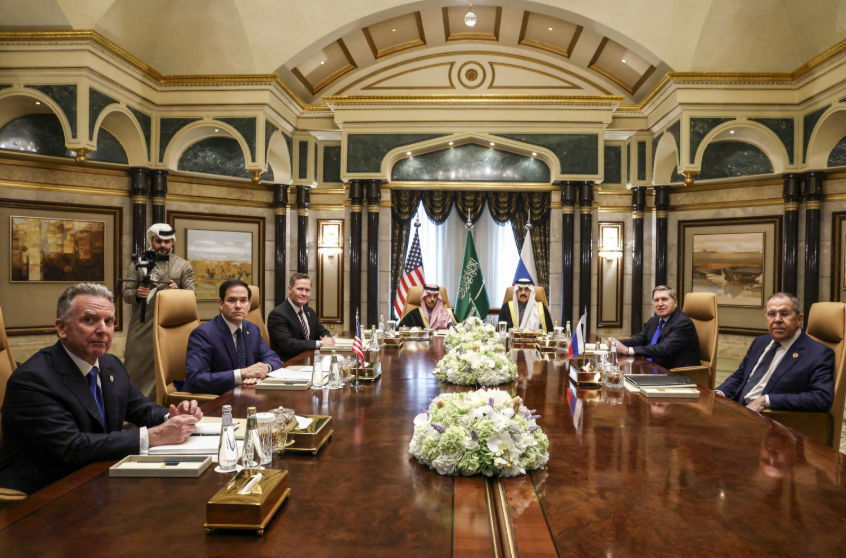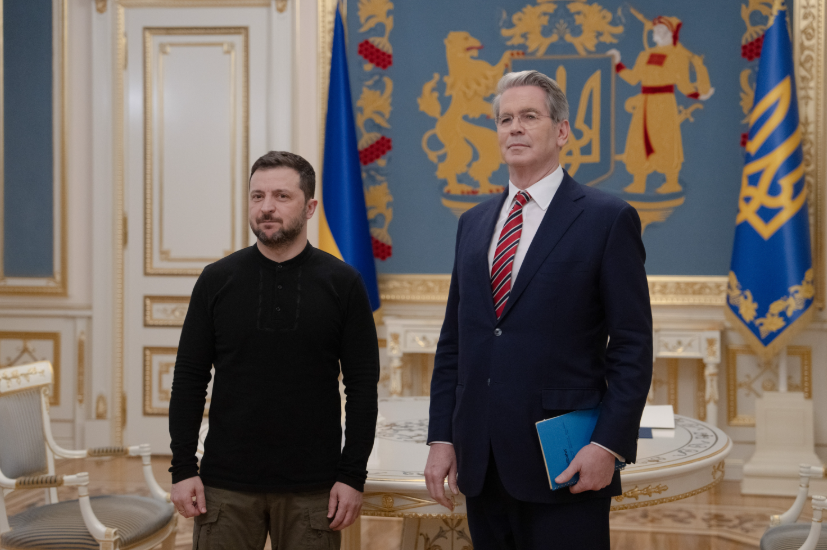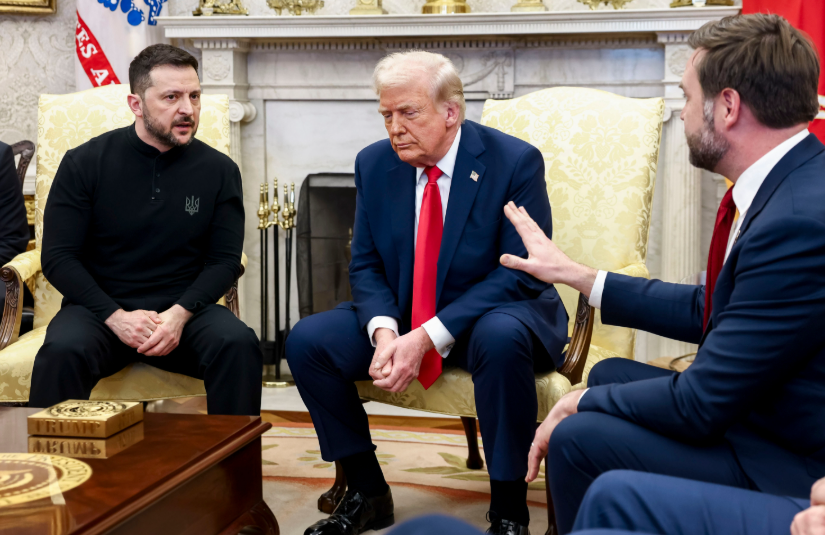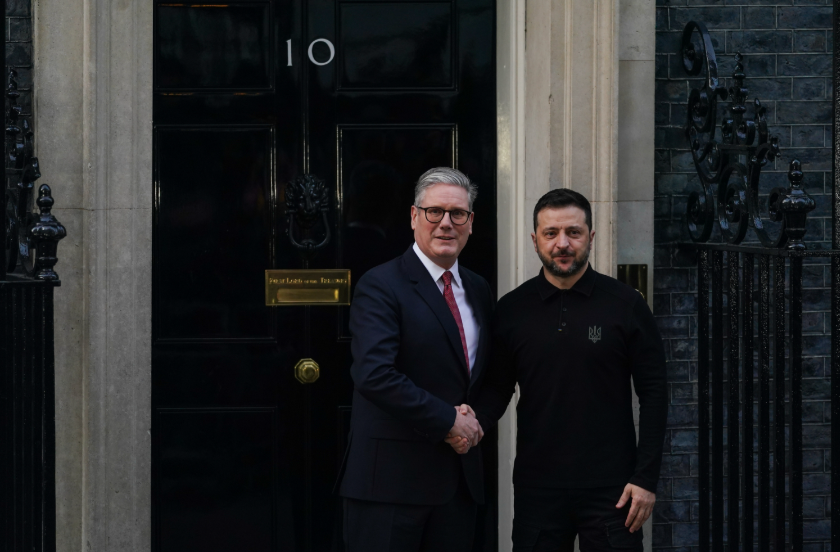A Month of Disillusionment: How February Reshaped U.S. Policy on Ukraine and What Kyiv Can Still Hope For
February 2025 marked a turning point in U.S.-Ukraine relations. Instead of the anticipated reset, Kyiv faced a series of sobering realities—from contradictory statements by the Trump administration to a failed White House meeting. Washington is now speaking less about Ukraine’s victory and more about compromises with Moscow. Is Kyiv prepared to adapt to this shifting landscape, and what are the implications of this course correction?
Donald Trump’s election as the 47th president of the United States is one of the defining factors shaping the trajectory of the war between Ukraine and Russia in 2025 and its potential resolution.
However, in the weeks following his inauguration, as well as before it, assessments of his impact remained largely speculative due to the lack of concrete policy statements or decisions from the new administration.
That changed in February 2025. The positions of Trump and his team began to take clearer shape, and their actions provoked reactions ranging from shock to frustration and outright anger—making this a true "month of disillusionment" for Kyiv.
But first, a look at the bigger picture.
The U.S. Domestic Agenda and Its Foreign Policy Consequences
To understand what Ukraine witnessed from the Trump administration in February 2025, it is paradoxically necessary to begin with U.S. domestic politics.
Alarming trends have emerged in the country, raising questions about the future of liberal democracy.
Under the pretext of a “mandate for radical change,” the administration has pursued policies that include:
- Targeting the civil service, led by Elon Musk. This includes the dismantling of USAID, large-scale reductions in government staff through enforced “vacations,” and appointments based on loyalty rather than competence.
- Pressuring the judiciary, which is accused of failing to reflect the “will of the people” and is therefore, by the logic of the Trump administration, must be deprived of the right to blocking government decisions.
- Restricting disloyal media access to government. Special envoy Richard Grenell has explicitly stated that U.S.-funded media, including Voice of America, must align with government policy.
- Controversial appointments of officials whose qualifications and past statements raise concerns, such as Pete Hegseth, Tulsi Gabbard, and Kash Patel.
These developments—alongside the absence of investigations into Russian interference in U.S. elections and Trump’s past ties to the Kremlin, as seen in 2017–2019—have allowed the 47th president to break with long-standing foreign policy traditions established after World War II.
For Ukraine, this shift has serious consequences.
Hegseth and Vance in Europe: The First Shock
The first clear indications of the new administration’s stance on Europe’s role in U.S. foreign policy and the Ukraine-Russia war came during visits to Europe by U.S. Secretary of Defense Pete Hegseth (February 11–14) and Vice President J.D. Vance (February 11–15).
At the Ukraine Defense Contact Group meeting (the Ramstein format), which was chaired for the first time by the United Kingdom instead of the U.S., Hegseth made a series of controversial statements:
- Restoring Ukraine’s 2014 borders is an unrealistic goal.
- Ukraine’s NATO membership is not a viable outcome of any negotiated settlement.
- Security guarantees for Ukraine should be provided by European countries by deploying their troops—but without NATO’s Article 5 protections.
These remarks could be interpreted as signaling a willingness to compromise with Moscow. However, many viewed them as unilateral concessions, given that Russia made no moves toward moderation and continued to push for maximalist demands.
From Ukraine’s perspective, focusing on that returning territories is “unrealistic” risks creating the false impression about what exactly is the primary obstacle to peace. In reality, the problem is Vladimir Putin’s refusal to end the war.
Moreover, there is a stark difference between preserving the right on NATO membership as a long-term challenge and abandoning that goal under external pressure—something the Kremlin has long sought.
Vice President Vance further shocked European allies at the Munich Security Conference, declaring that the greatest threats to Europe do not come from Russia or China but from within. According to him, national elites and EU institutions ignore the will of their citizens, who demand radical change.
Significantly, this statement came just before Germany’s Bundestag elections, where Elon Musk openly supported the far-right Alternative for Germany.
Vance’s remarks struck at the heart of transatlantic unity, a pillar of efforts to counter Russia and support Ukraine.

Riyadh Talks, Zelensky’s Legitimacy Under Attack, and a UN Vote: The Second Shock
As Trump administration officials toured Europe, Donald Trump himself held a 90-minute phone call with Vladimir Putin on February 13, effectively ending the informal moratorium on direct U.S.-Russia leader-level contacts that had been in place since February 24, 2022. Neither European allies nor Ukraine were informed in advance, a departure from standard practice, where such discussions are typically coordinated with partners.
High-level U.S.-Russian talks followed in Riyadh on February 18, culminating in the formal announcement of an expert group to discuss settlement terms. However, fundamental differences remained: Russia and Ukraine’s positions on occupied territories, NATO, and the structure of the Ukrainian military were irreconcilable, making any compromise almost impossible.
Moscow’s preferred roadmap—ceasefire, elections, final agreements—raised concerns that democratic processes could be weaponized to destabilize Ukraine from within.
At the same time, rhetoric questioning the legitimacy of President Volodymyr Zelensky began to surface in U.S. political circles. Trump administration officials echoed these claims, fueling speculation that the White House viewed Zelensky as an obstacle to a settlement because of his insistence on protecting Ukraine’s sovereignty and security. As a result, both Russia and the U.S. launched simultaneous attacks on Zelensky’s legitimacy.
Amid this, the United States refused to label Moscow as an aggressor in G7 and UN General Assembly statements. The G7 failed to adopt a joint declaration marking the anniversary of the full-scale invasion, and for the first time, Washington voted against a Ukrainian resolution at the UN, instead proposing a more neutral alternative.
Many interpreted these moves as a shift in Washington’s role—from supporting Ukraine to positioning itself as a mediator between Kyiv and Moscow. Further statements from Trump and his team only reinforced this perception.

Ukrainian Resources in Exchange for U.S. Support
While the Trump administration toured Europe and engaged with Russia, another high-stakes negotiation unfolded: U.S. efforts to secure access to Ukraine’s natural resources.
On February 3, Trump publicly linked continued U.S. military aid to a potential minerals deal. Four days later, Zelensky expressed his openness to economic cooperation but stressed that Ukraine’s resources required protection—meaning security guarantees were necessary. He also added that an agreement should be a mutually beneficial partnership, not a one-sided transfer of assets.
The concept of joint resource development was not new. It had been introduced in Ukraine’s Victory Plan in September 2024, which paired security guarantees with economic cooperation.
However, on February 10, Trump reframed the proposal, portraying it as a form of reimbursement for past U.S. assistance to Ukraine. He cited a $500 billion figure, though official data presented a starkly different picture:
- Total direct U.S. aid to Ukraine amounted to $106 billion.
- Of that, $70 billion was spent on the American defense industry, meaning it never left U.S. territory.
- Only $33.3 billion was allocated for Ukraine’s macroeconomic stability, with $2.8 billion designated for humanitarian aid.
The gap in interpretations fueled tensions.
On February 12, U.S. Treasury Secretary Scott Bessant arrived in Kyiv with a draft agreement, expecting immediate approval. Washington hinted that if Zelensky declined, his planned meeting with Vice President J.D. Vance and Secretary of State in Munich on February 14 might be canceled.
Trump and his team grew frustrated with Kyiv’s reluctance to accept the deal unconditionally. Ukrainian officials had legitimate concerns—both over the agreement’s financial terms and the absence of concrete security guarantees.
Intense negotiations continued for two weeks, set against an increasingly confrontational backdrop. Ultimately, the parties agreed to sign a memorandum of intent and explore the creation of a Reconstruction Investment Fund. The final agreement was postponed, with a formal signing planned for Zelensky’s visit to Washington on February 28.
For Kyiv, the visit was likely an attempt to counterbalance U.S.-Russian contacts in Riyadh, where Ukraine had been excluded. This may explain why Andriy Yermak, head of the Ukrainian presidential office, backed the trip, while U.S. special envoy Keith Kellogg reportedly advised against it.
During his visit to Kyiv on February 19–20, Kellogg even requested that no joint press conference be held, fearing that public attention would highlight deepening U.S.-Ukraine disagreements and complicate the broader diplomatic effort.
Rhetoric of Trump and his team: What are the Risks
Throughout February 2025, Donald Trump and his team advanced several narratives regarding the origins of the Russia-Ukraine war and potential settlement scenarios. Three key themes stand out as particularly concerning.
“Ukraine is to blame for the war.” Trump and his allies have suggested that the full-scale Russian invasion on February 24, 2022, could have been avoided had Kyiv made concessions to the Kremlin. However, Moscow has consistently demanded Ukraine’s surrender—insisting on neutrality, a reduced military, and abandonment of NATO aspirations.
“NATO provoked Russia.” Equally problematic are claims that NATO expansion and Ukraine’s membership ambitions triggered the war. U.S. Special Envoy Steven Witkoff, who has been engaging with Moscow, drew particular attention when he stated that the 2022 Istanbul agreements could serve as the basis for a peace deal. Those agreements, however, would have required Ukraine to renounce NATO membership, accept neutrality, and limit its armed forces—effectively undermining its sovereignty.
“Peace at any cost.” Another concerning message is the call for an immediate end to hostilities, regardless of the conditions. Statements such as “Don’t you want peace that will save lives?” echo longstanding Russian propaganda efforts to portray Ukraine as the party prolonging the war. This narrative overlooks the reality that without security guarantees, any ceasefire would only pave the way for a renewed Russian offensive. A similar dynamic played out with the Minsk agreements, which failed to prevent Moscow’s full-scale invasion in 2022.
Notably, Elon Musk has become increasingly vocal in promoting this line of thinking.
As the Trump administration’s rhetoric increasingly aligns with Moscow’s framing of the conflict, there is a growing risk that Washington may shift toward policies that serve Russian interests.

Oval Office Clash
February 28, 2025, was meant to mark a resolution in U.S.-Ukraine tensions, with the expected signing of a minerals-for-aid agreement. Instead, a heated exchange in the Oval Office derailed the deal.
The agreement was not signed. Zelensky was asked to leave the White House early—skipping the traditional working lunch with the U.S. president.
In Ukraine, debate continues over who bears more responsibility for the dispute. However, the deeper issue remains clear: the two sides’ strategic interests are fundamentally at odds.
The Trump administration is eager to broker an end to the conflict, presenting it as a major diplomatic achievement. To that end, Washington appears willing to prioritize a deal over Ukraine’s sovereignty, security, and territorial integrity.
Kyiv, by contrast, is determined to avoid past mistakes, when U.S. attempts at rapprochement with Russia came at Ukraine’s expense. That’s why Zelensky has remained firm on sovereignty and security guarantees—a position that has frustrated Trump and his team.
Thus, the Oval Office confrontation only confirmed what had already become apparent: Ukraine and the United States are no longer aligned on key issues. Constructive relations are difficult to maintain when Kyiv’s core concerns find little traction in Washington.
There is now a real risk that Trump will use the dispute as justification for scaling back aid to Ukraine, portraying Kyiv as uncooperative. Even before the Oval Office clash, his administration had signaled skepticism about maintaining support at 2022–2024 levels.

Ukraine’s Next Steps
By February 2025, Ukraine had swiftly shifted from Plan A—engaging with Trump in pursuit of compromise—to Plan B—seeking alternative strategies with European partners.
How Kyiv will manage relations with Washington going forward remains an open question. Key indicators will include the level of bilateral engagement, the fate of the minerals agreement, and U.S. security commitments.
Meanwhile, Trump and his team appear to be employing a “good cop, bad cop” approach. While the president leaves room for negotiation, presenting the minerals agreement as a de facto security guarantee, his aides have increased pressure on Zelensky—demanding public concessions, resignation, and new elections in Ukraine.
This dynamic is shaping an unsettling Faustian bargain: to maintain even minimal U.S. support, Ukraine may be expected to compromise on fundamental issues of sovereignty and security—potentially jeopardizing its long-term future.
It is far from an ideal choice.
Поділитись

